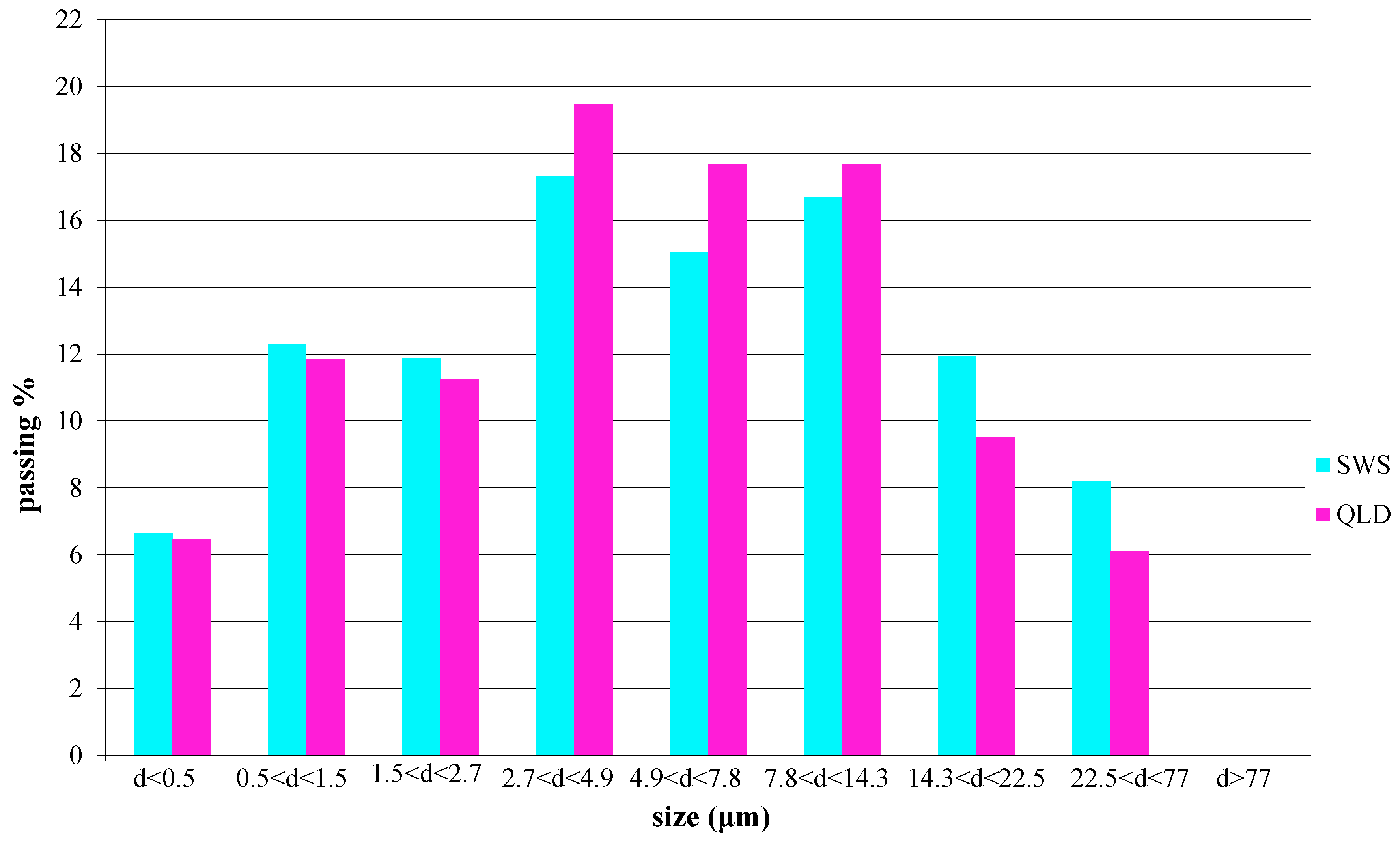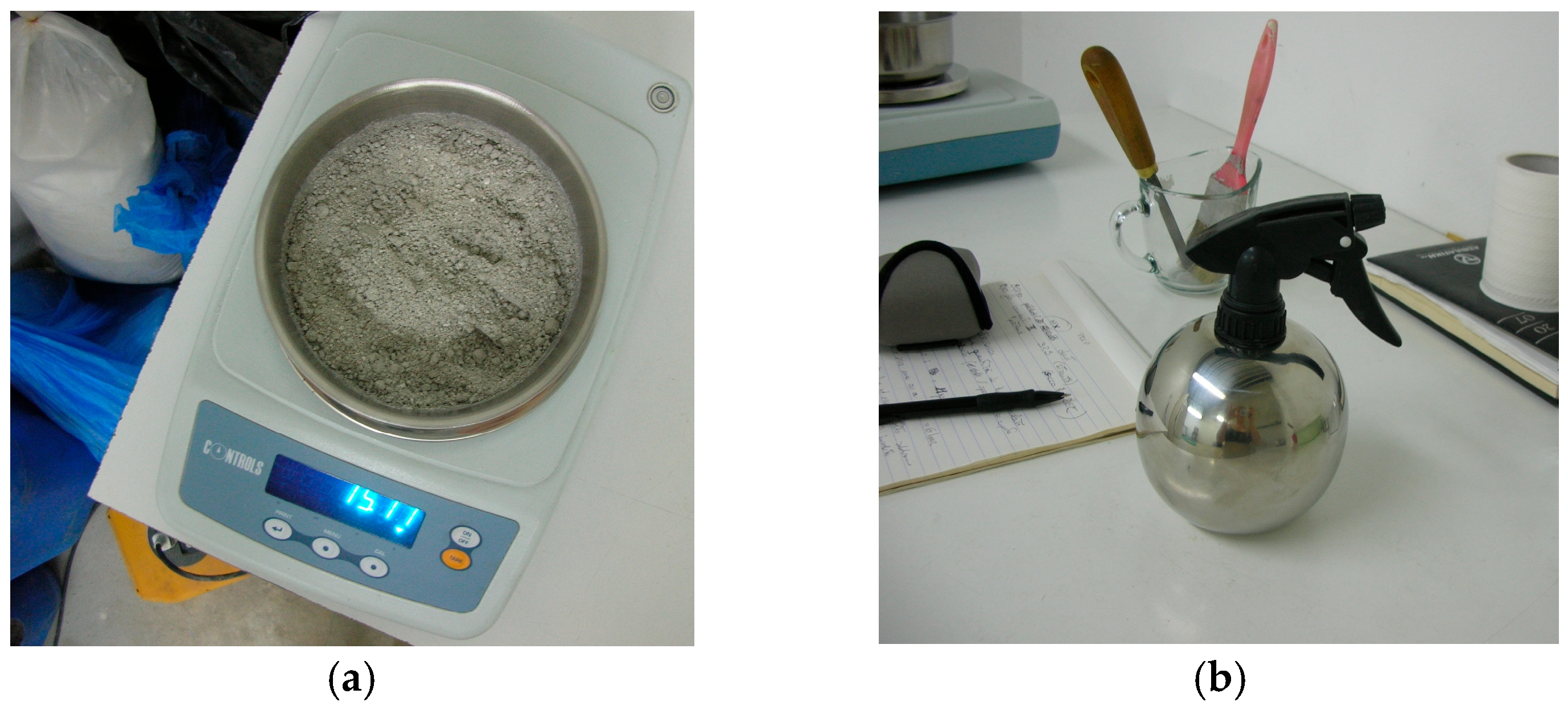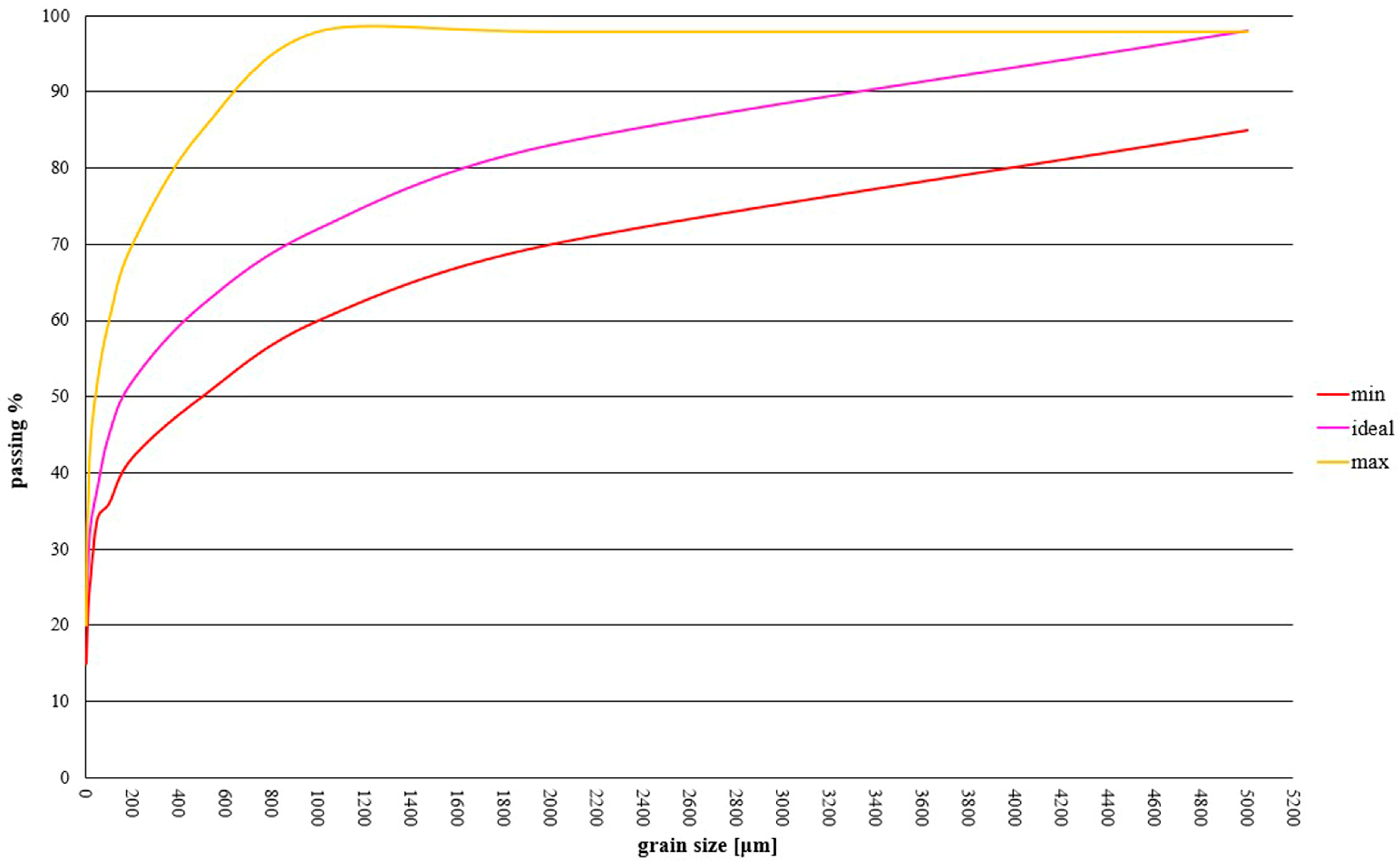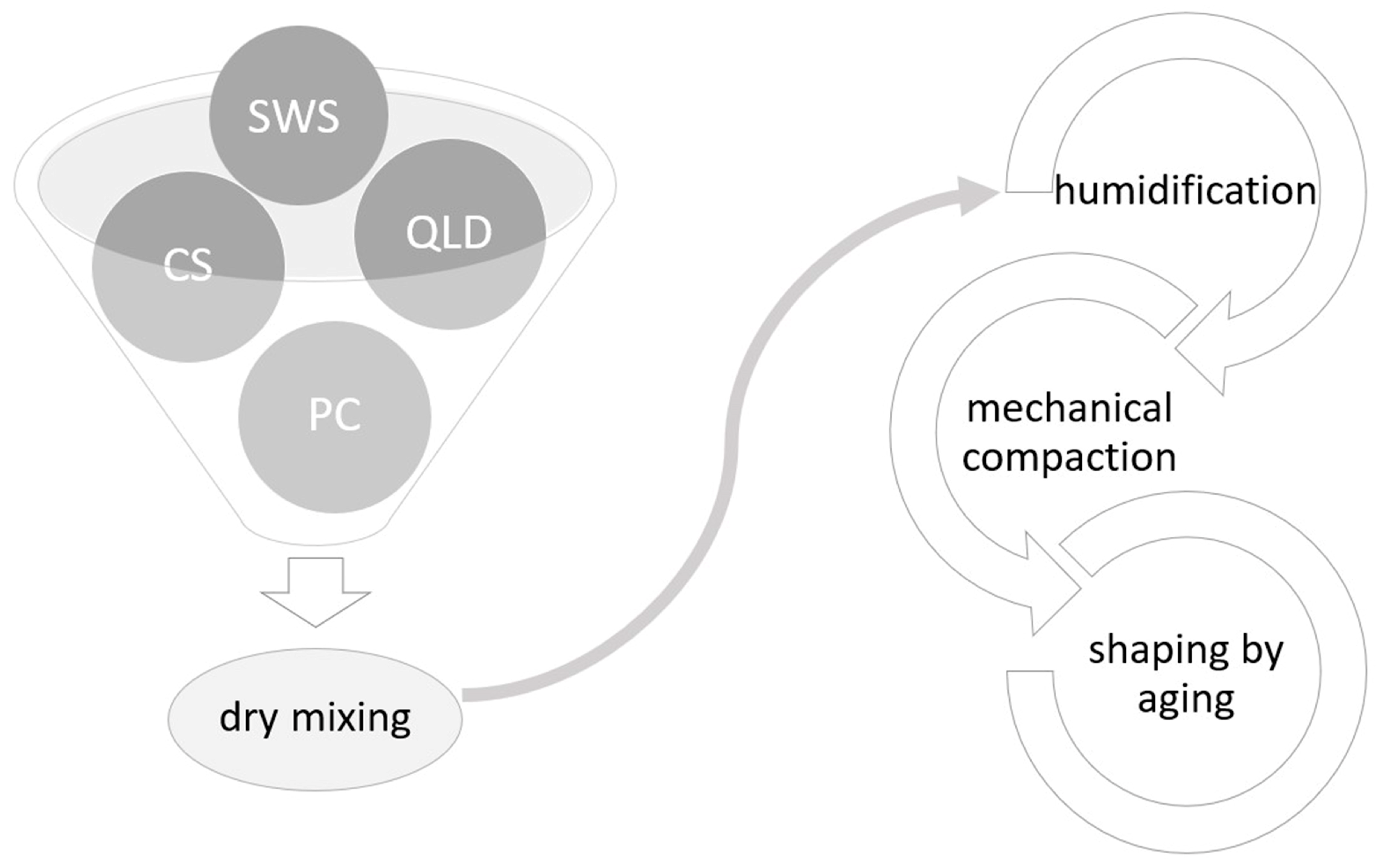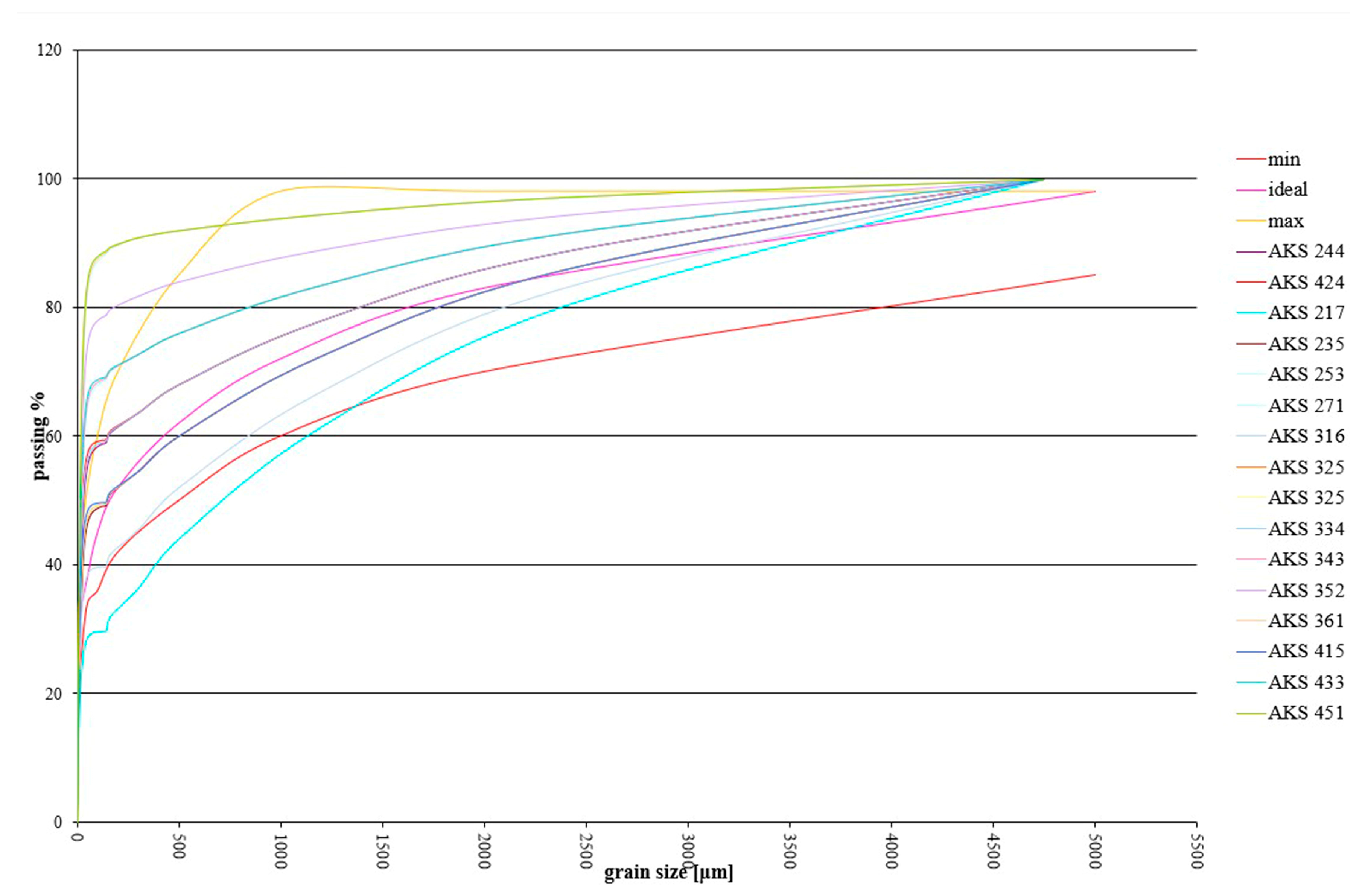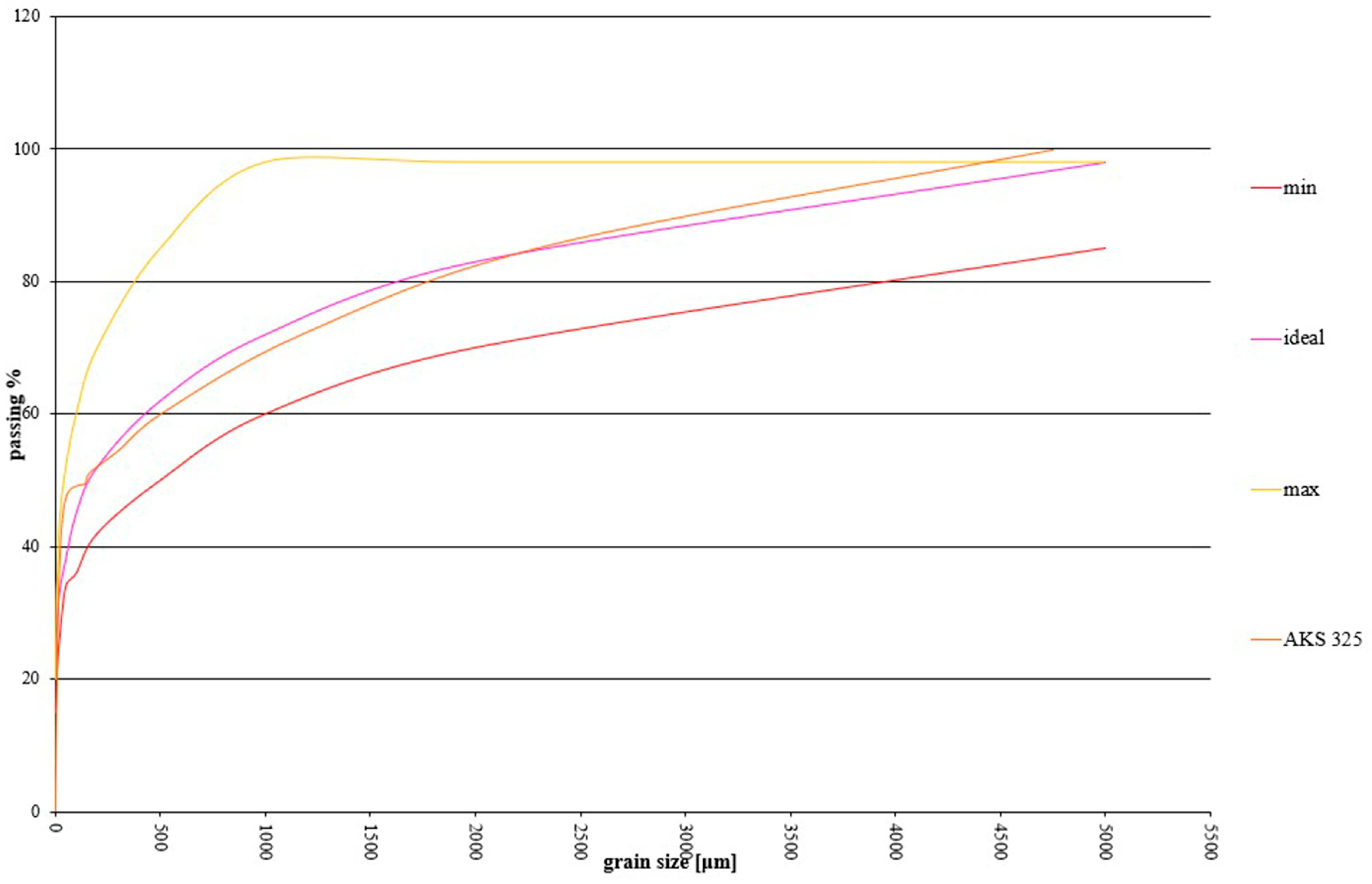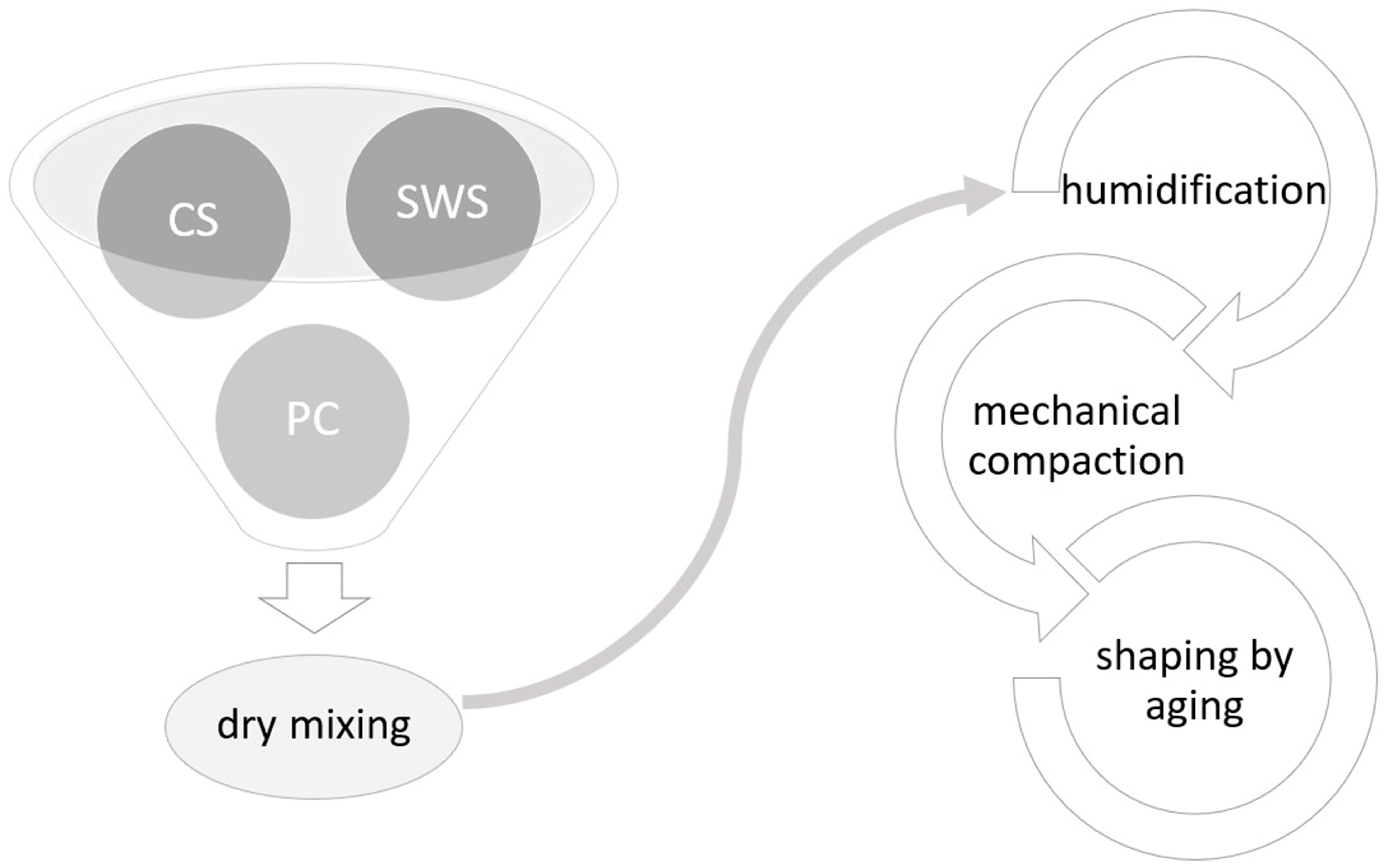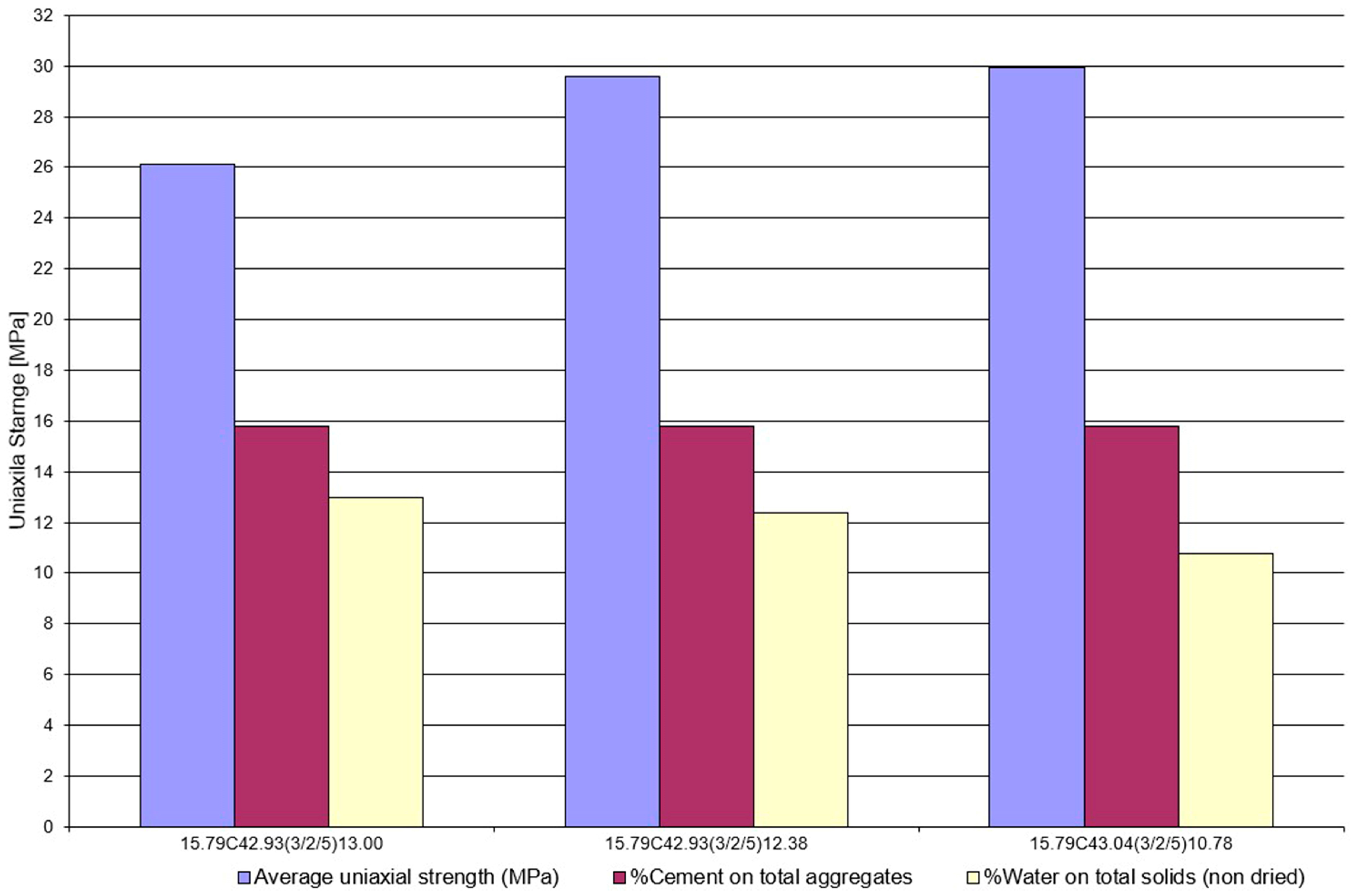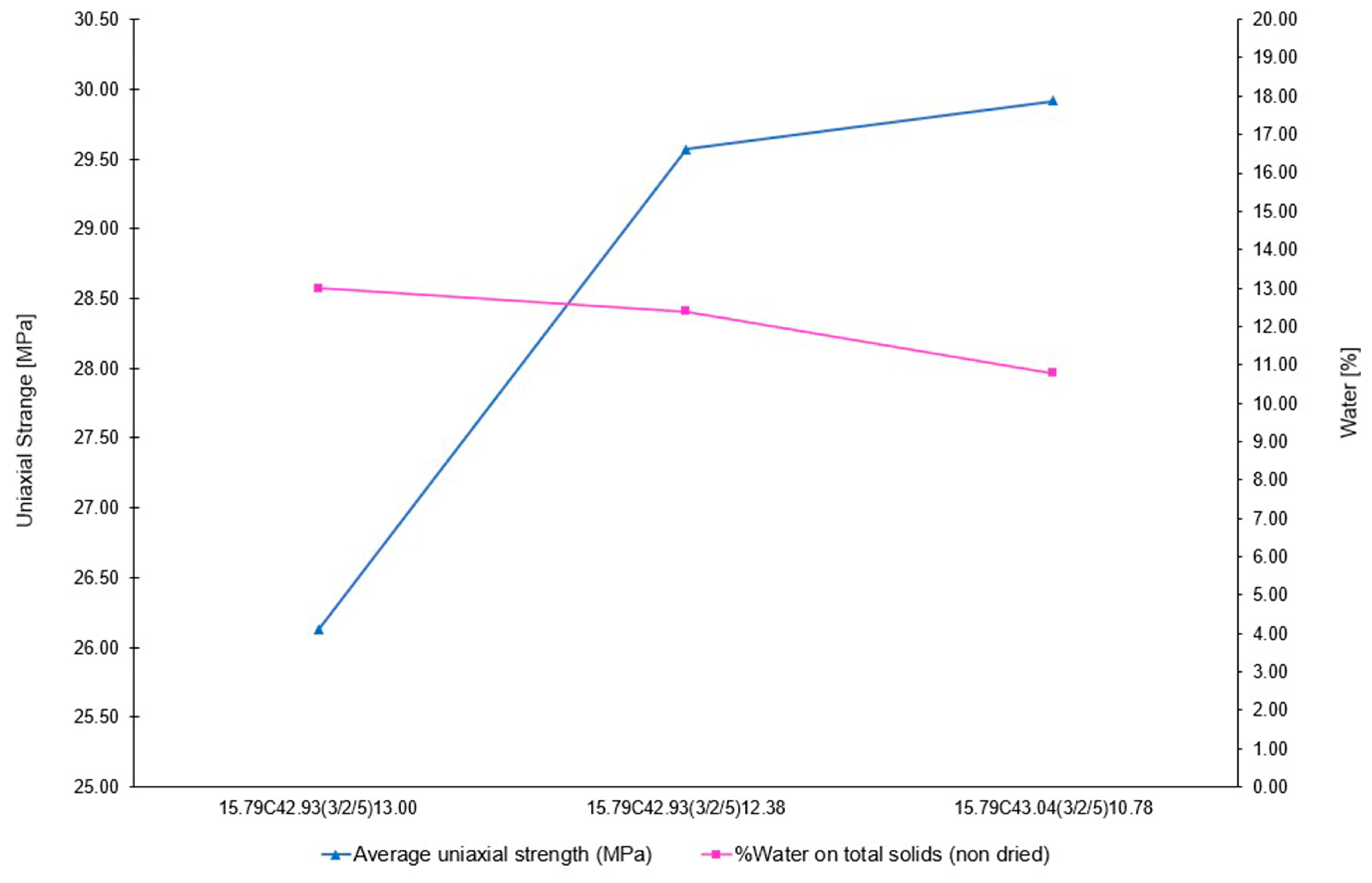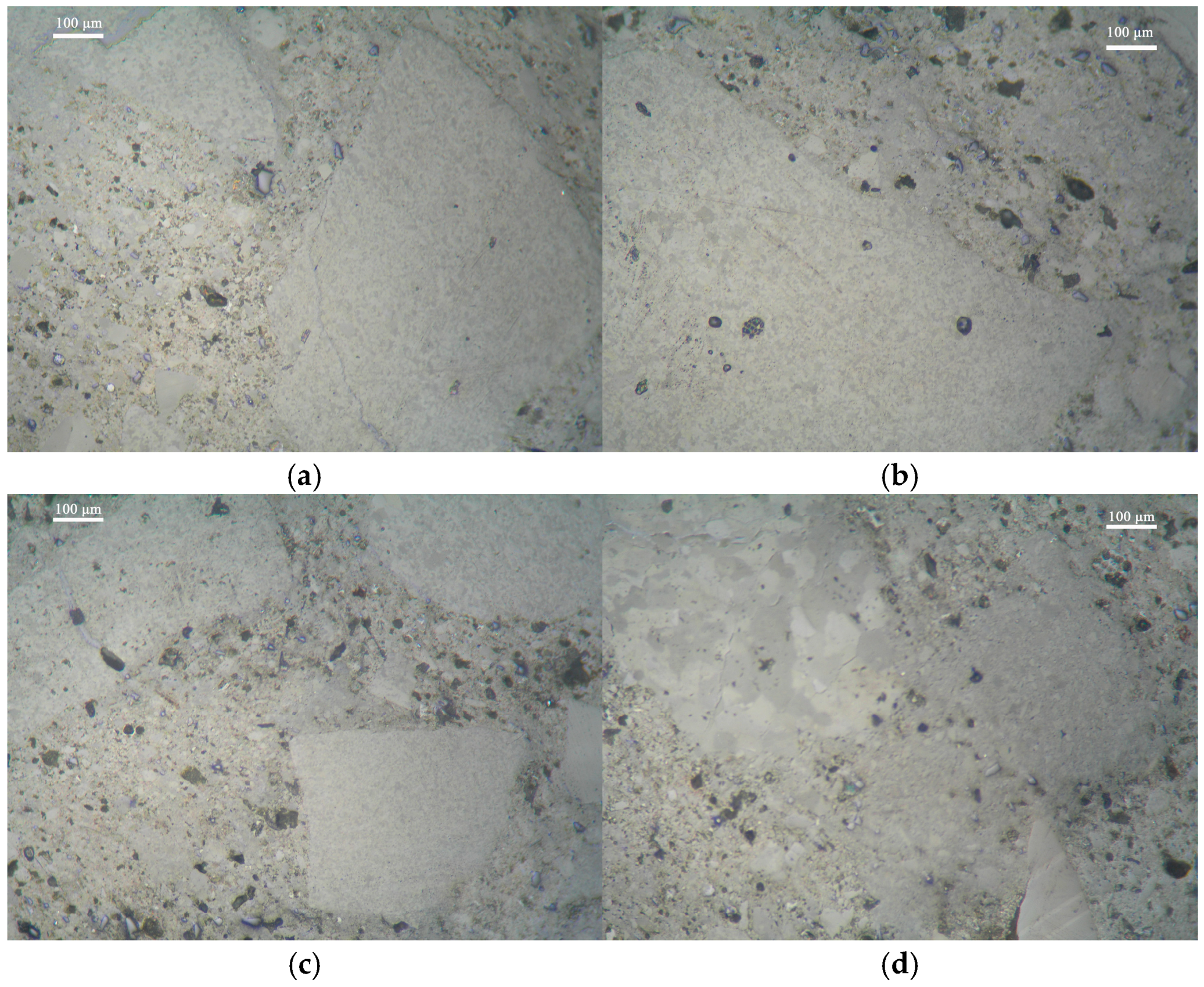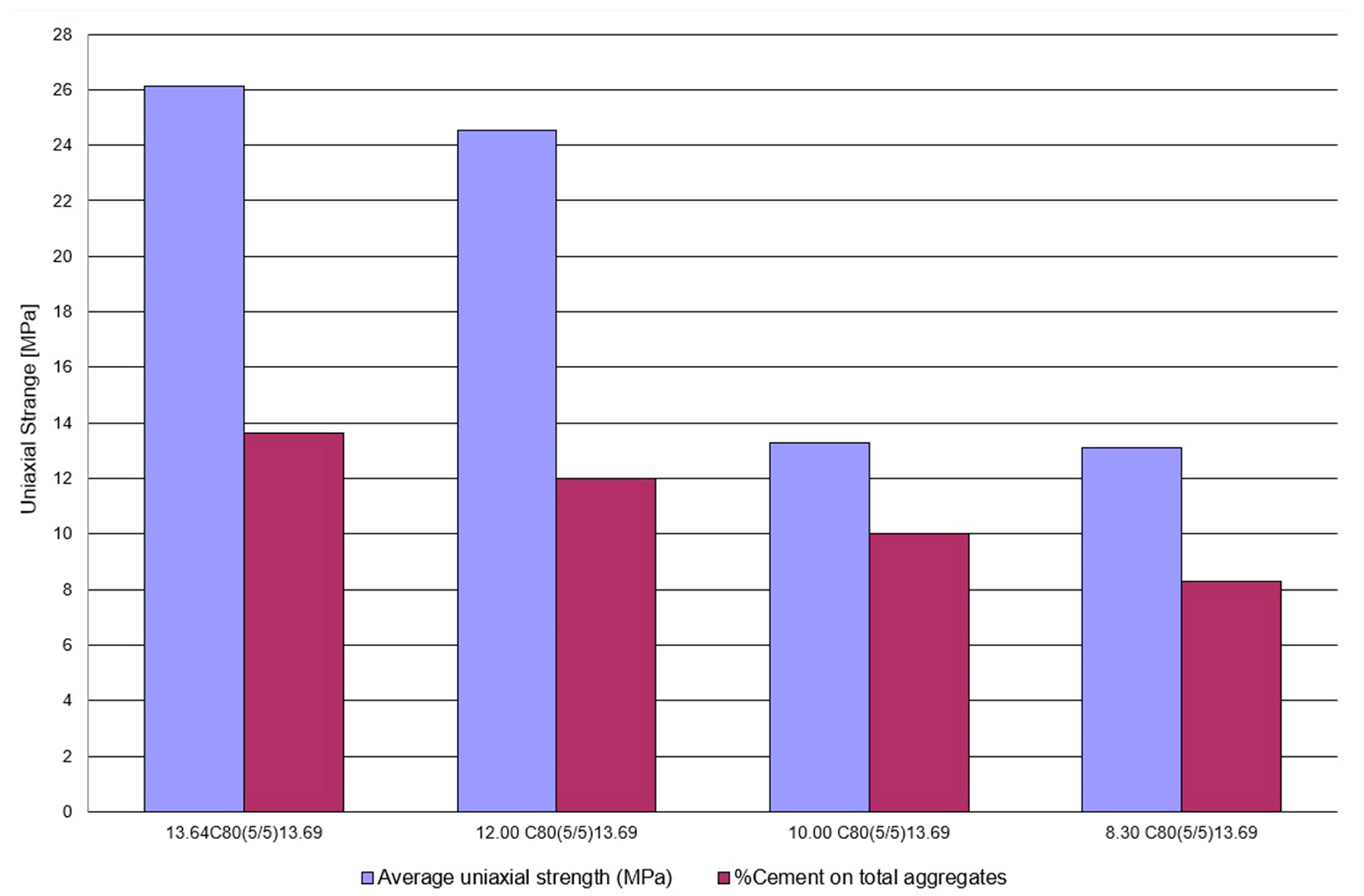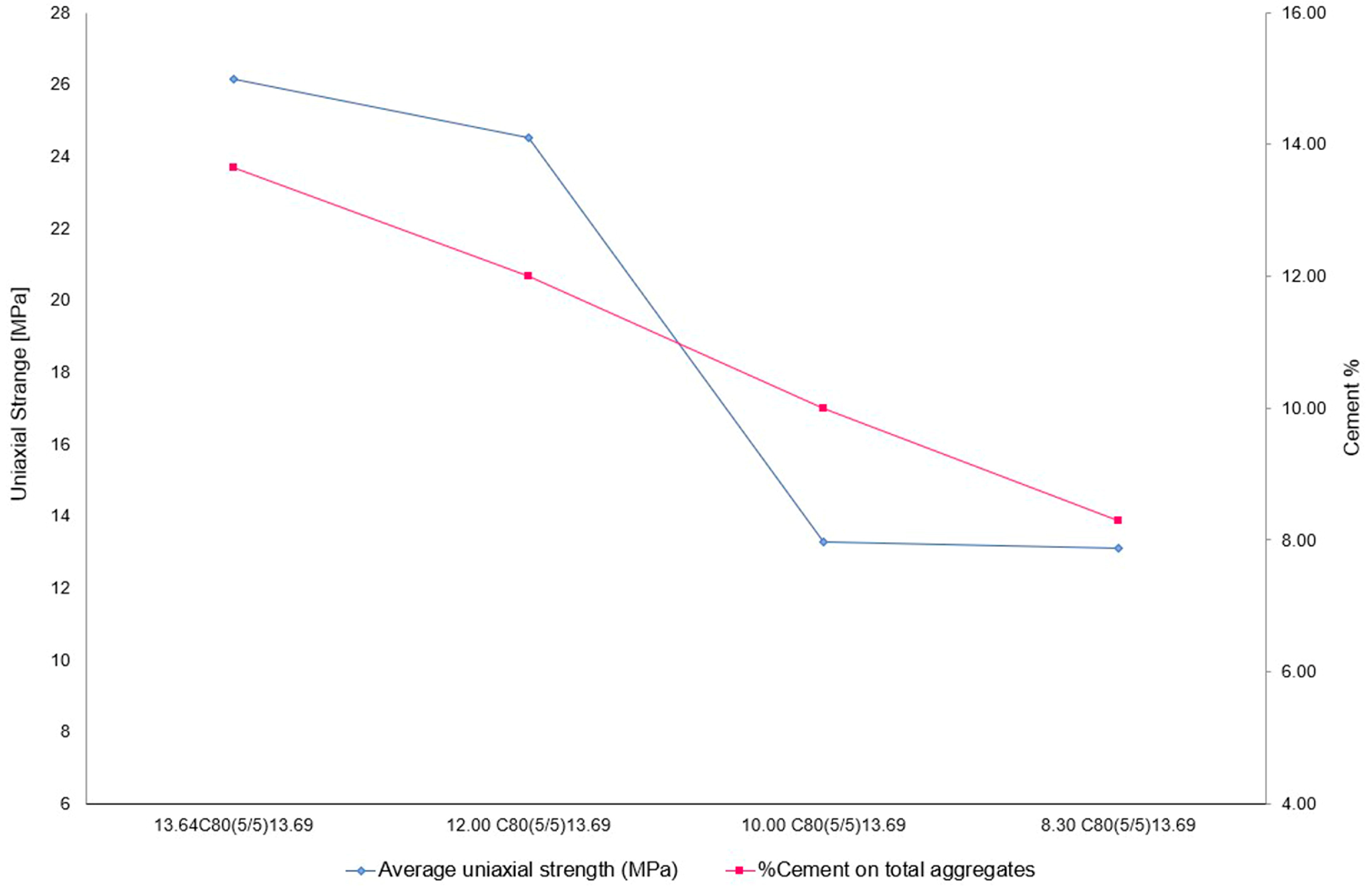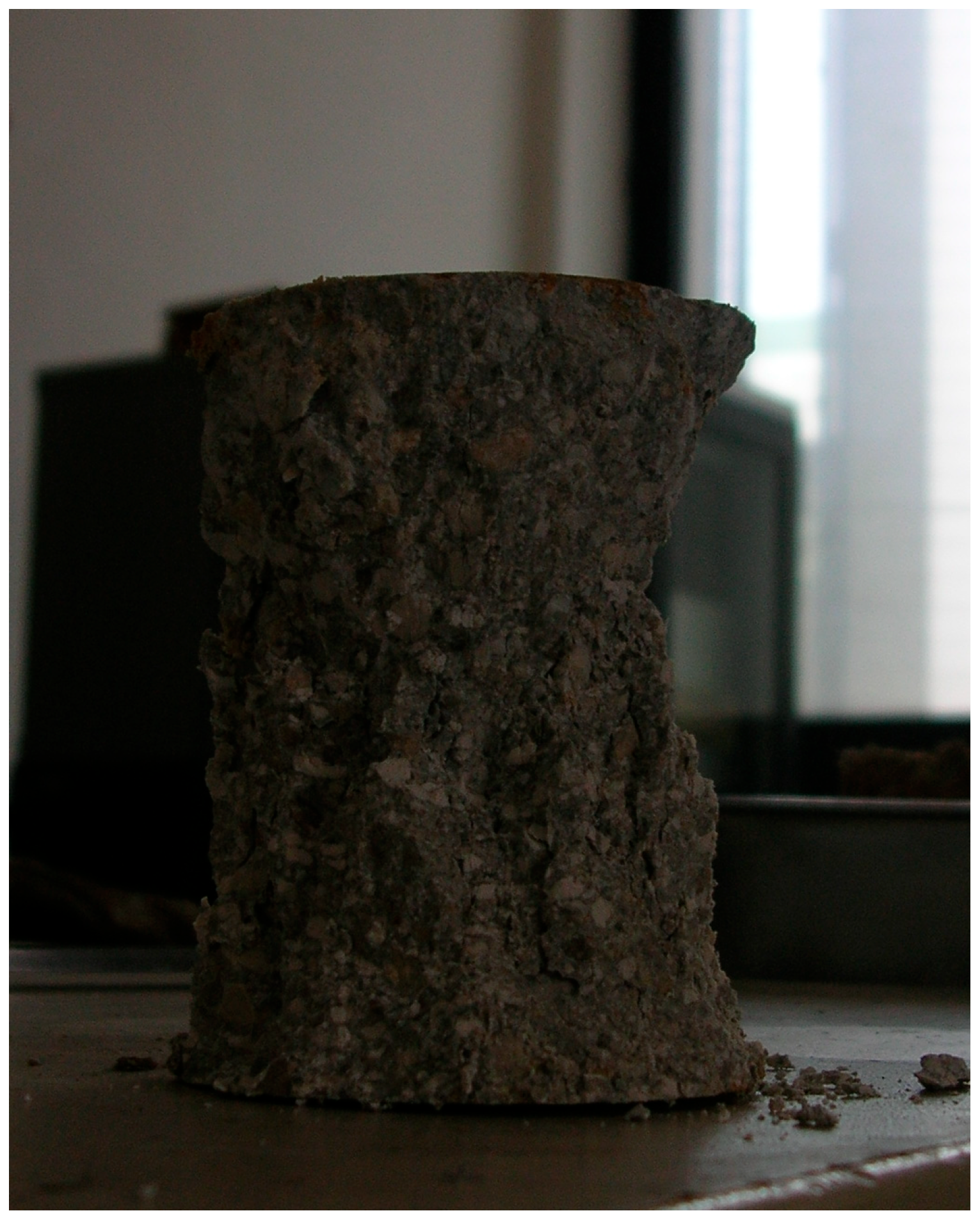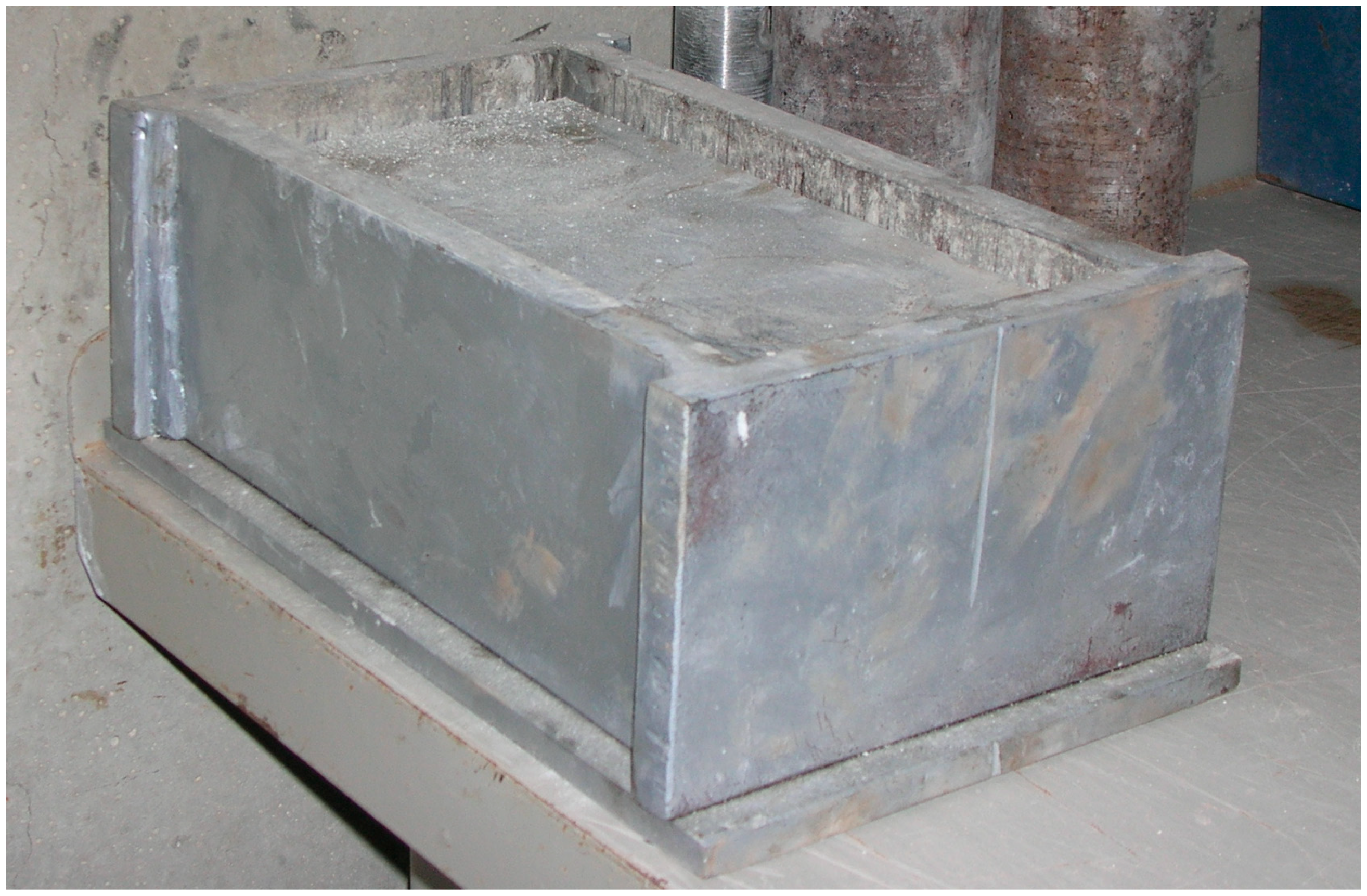1. Introduction
The construction industry involves activities with some of the highest consumption of raw materials and significant waste generation [
1,
2,
3,
4,
5,
6,
7,
8]. According to the European Commission, it requires large quantities of resources, accounting for about 50 percent of all the materials extracted and accounting for more than 35 percent of the EU’s total waste production [
9].
Among the various activities, particularly incidental is the production of natural stone building components and the production of cement mortars and concretes.
In relation to the production of mortars and concretes, according to the data from the Global Cement and Concrete Association, global concrete production amounts to about 14 × 10
13 m
3/year. This massive use leads to the predominant extraction of raw materials for cement and concrete aggregates, making them the most mined mineral resources globally [
10,
11].
The quarrying and processing of stone involves two primary mechanical processes that generate a significant amount of waste of various types: large waste and debris, granules, dust, and stone waste sludge known as marmettola (SWS). The waste generated from the cutting and processing of stone can range from a minimum of 35 percent to a maximum of 75 percent of the stone product, and on average, the SWS is 22.5 percent of the raw material processed [
12].
Such waste is now a serious environmental problem because, if it is dumped on the ground, it can reduce the filtration rate of rainwater and degrade soil fertility, and if it is dumped into rivers, streams, and oceans, it contaminates the water [
13].
Consequently, the need to reduce the extraction from nonrenewable sources, as well as the amount of products going to landfill, becomes an essential imperative to safeguard natural ecosystems for future generations [
13,
14,
15].
To date, the main use of SWS is landfilling, but there are numerous studies and research conducted for their reuse in so many areas. These approaches consider the life cycle of the material and adopt circular economy principles.
For example, the potential applications include the use of SWS as a neutralizing agent for acidic wastewater in the glass industry [
16], as a heavy metal removal agent for industrial wastewater [
17], and in flue gas desulfurization in high-power industrial burners using both dry and wet technologies [
18,
19,
20]. Within the construction industry, numerous studies highlight the use of stone processing waste as a secondary raw material in the formulation of innovative materials for the production of tiles [
21], cement [
22,
23,
24], mortar [
25,
26,
27,
28], concrete [
29,
30,
31], and bricks [
32,
33,
34]. In these formulations, SWS can replace or supplement cement and/or fine aggregate at different percentages. Its high fineness provides good mix cohesion, increases its workability, and reduces concrete’s permeability. In many cases, such experiments also involve the use of both organic and inorganic additives. In addition to the cement matrix, other studies involve the use of SWS in lime-based products [
12], polymer matrix materials, and 3D printing materials [
35].
In the literature, some reviews are available about the use of stone waste in concrete, studying the effect of the partial substitution of aggregates and cement in concrete. Some of them [
36] carried out a portfolio of the state of the art on the reuse of ornamental stone and have investigated more the strengths and weaknesses of using stone waste in polymer composites, providing a waste stream classification. Others [
37] have reviewed scientific contributions about the use of marble, including mining and processing waste, focusing on the impact of replacing traditional components with waste on the technological performance of concrete in its fresh and hardened state, such as its mechanical properties and durability. The results show that with the use of marble powder, with a replacement rate of 10%, the cement does not reduce the performance of concrete and mortars. When employed for the substitution of fine and coarse aggregates, marble waste can reach higher percentage contents, between 50% and 75%, optimizing the reuse of higher quantities of waste. Nevertheless, the geological nature of the coarse aggregates and the particle size distribution of the fine aggregates replaced by dust influence the final properties. It should be noted that the different chemical and mineralogical characteristics of the raw material from which SWS is produced determine the most appropriate application scenarios. In particular, it is possible to distinguish SWS from marble, SWS from granite, and SWS from limestone. Among the most common reuse scenarios are the following: the packaging of bricks and tiles with marble SWS [
38,
39] and granite SWS, sometimes fired with clay mixtures; the packaging of ceramics and stoneware with granite SWS [
40]; and the packaging of concretes and mortars with marble SWS [
41] and limestone SWS. However, little research has been performed on the possibility of using limestone SWS in the formulation of mixtures for the production of building blocks. Therefore, the contribution aims to investigate the possibility of manufacturing building blocks with the use of limestone SWS and products through simple and low-impact processes. With reference to the issues outlined, the paper describes the research pursuing the following objectives:
Reduce the amount of raw materials mined, such as sand, for the production of mortars and cements.
Reduce the amount of waste disposed of in landfills.
Experiment with high-performance, low-cost construction materials with simple production processes.
These objectives have been achieved through the study and experimentation of innovative mixtures for the production of concretes and blocks using SWS aggregates that give high performance and recover waste from the supply chain.
The innovation of this study lies in the mix design approach, the production process, and the evaluation of the resulting properties. These characteristics have been compared with the current Italian regulations, and the potential applications of the tested products in the construction sector have been identified. The aim is to guide the construction and building materials industry towards innovative and circular solutions for the production of more sustainable building elements through the use and valorization of SWS. The results obtained show that it is possible to use significant quantities of such waste to produce building blocks that can be manufactured using few raw materials, without additives and using simple and inexpensive production processes. For example, no baking or energy-intensive production processes are required.
2. Materials and Methods
2.1. Design Approach
In the approach to studying the possibilities of using SWS as a raw material for building materials, some design guidelines have been defined as follows:
Repurpose as much as possible the basic recipes historically used to make artificial stone.
Use a cementitious matrix binder.
Minimize the binder use.
Produce mixes with few raw materials.
Produce low-cost mixes.
Use simple production processes that are already in use.
In the panorama of studies carried out in this field, the research of M. Galetakis [
42,
43] is very similar to the one presented here, in terms of intention and the materials used. These studies deal with the development of building materials using waste materials from the processing of stone materials, such as quarry limestone dust (QLD), which is obtained from the grinding of the same in the process of producing aggregates for asphalt mixes and Portland cement (PC). This research has been referred to for the general framework and methodological approach of the work reported here.
The production cycle proposed here includes the same steps as those used in the production of structural artificial stone: dry mixing of the raw materials, humidification with a quantity of water limited to that necessary for amalgamation, introduction into molds, mechanical compaction, and shaping by the aging of the elements [
44].
Compaction involves applying mechanical energy to the compound to “rearrange” its particles and reduce the number of voids. This process strengthens the material by increasing its shear strength and reducing its water permeability. The compaction results are obviously influenced by a number of factors, such as the water content of the material, the type of material being compacted, and the amount of energy used for compaction.
The production cycle then includes the steps shown in the flowchart (
Figure 1).
2.2. Materials
The materials used in the trial are limestone sand (CS) for the production of mortars, water (W), PC, and finally QLD and SWS as ultrafine materials. The waste was taken from the stone production processes of the marble basin of Apricena.
The PC used was of the type, CEM I 42.5 R, conforming to the prescribed composition of UNI EN 197-1:2011 [
45];
The W was as required by UNI EN 1008:2003 [
46];
The CS used was natural standard sand (according to CEN EN 196-1 [
47])
SWS consists of stone processing waste generated in wet stone processing plants, the characterization of which was performed in a previous study [
12], the results of which are presented below.
Mineralogical analysis was carried out via X-ray diffractometry, and the results show that the main phase is calcite (CaCO
3), while traces of Dolomite (MgCa(CO
3)) and hematite (α-Fe
2O
3) were detected as compounds. The results of TG-DTA show a sample mass loss of 43.30%, and a calcium carbonate content of 98.41% by mass. The experimental data were confirmed via the hydrochloric acid attack performed on two powder samples, and indicate an average value of non-carbonate impurities of 1.56% by mass and a calcium carbonate content equal to 98.44% by mass. The chemical composition of SWS was determined via X-ray fluorescence spectrometry, which was also used to support the XRD analysis carried out quantitatively. The results show that SWS is composed mainly of CaO (55.6%), and all the other components (Fe
2O
3, Al
2O
3, SiO
2, Na
2O, K
2O, TiO
2, SO
4, CO
2) were present in amounts less than 0.1% except MgO (0.25%). The results of the eluate analysis show that with reference to the Italian Regulations [
48], the SWS was found not to be “non-hazardous waste”, and can be designated for recovery. The specific gravity is 2.80 g/cm
3. The moisture content of the SWS is equal to 23.5%.
The test performed to measure the ISO brightness level showed a very high and almost pure degree of whiteness with a value of 93.5% ± 1. The particle size distribution of the solid particles, obtained by using the laser diffraction method, shows that the maximum particle size, expressed as the equivalent diameter, was equal to 77 μm. Only 8% of the mass had a particle size between 22.5 μm and 77 μm, while the remaining 92% of the mass had a particle size below 77 μm. Only 8% by mass had a particle size between 22.5 μm and 77 μm, while the remaining 92% by mass had a particle size below 22.5 μm, with 7% by mass having a particle size below 0.5 μm. The Blaine specific surface area was 9273.79 cm2/g. This value confirms the significant fineness of SWS.
QLD, derived from stone crushing in the aggregate production process in Crete, was used in the first phase of the study and was analyzed by Prof. M. Galetakis [
36,
37] who compared it with the results obtained for SWS. QLD and SWS have mineralogical compositions that were analyzed using completely similar X-ray difractometers. They consist primarily of calcite (approximately 98% by weight) with traces of other elements such as quartz and dolomite. The chemical compositions are also similar (
Table 1), with an absolute prevalence of CaCO
3 present in amounts greater than 98%, with a difference of 0.22% between QLD and SWS.
In contrast, the particle sizes of the two types of waste analyzed were slightly different (
Figure 2 and
Figure 3). Although they are mostly ultrafine materials, it appears that SWS contains the largest amount of ultrafine material, while QLD produced for the production of concrete aggregate tended to be slightly larger in diameter.
The specific surface area measured by using Blaine’s air permeability method confirmed that sludge is the finer material than the two types of powder analyzed (
Table 2), and its permeability is the lowest.
The degree of compaction of the materials was then tested to find the maximum load beyond which the volume loss of the two samples was insignificant. For this purpose, two slurries were prepared with one of two types of waste, cement and water. The resulting information was used to determine the compaction pressures to which the specimens would be subjected in the next steps. Each slurry, following the research settings initiated by Prof. Galetakis [
42], consisted of 80 g of recycled aggregate and 15 g of Portland cement mixed dry and moistened with enough water to make the slurry wet (
Figure 4).
The doughs obtained were placed in cylindrical molds with an internal diameter of 50 mm and a height of 80 mm and compacted in a load cell (
Figure 5) through a stress–strain cycle.
The results obtained (
Figure 6) highlight that the specimens containing QLD had an initial settlement of about 50 percent of the total, which occurs very quickly and at small load increments, while the compaction values of the specimen containing SWS were lower, the process occurring more slowly than at higher pressure values. This again reflects the different grain size of the SWS, which is finer than the powders and therefore has a better initial grain distribution with fewer voids, even before the compaction stage. It could be observed that the relative decreases became insignificant after the application of forces of 60–70 kN for SWS, and 50–60 kN for QLD.
2.3. Experimentation Activity
A Spanish commercial product, the Hyperbrick [
49], was used as a reference for the design of the doughs, and is well suited to the materials to be processed as well as to the principles and procedures identified. It is a “regenerated stone”, homogeneous, and without inclusions, packed in solid and hollow structural bricks, obtained by cold compression of natural inert materials with fine and ultrafine grain size and PC used in small quantities.
The high pressures to which the mixture is subjected make it possible to obtain a high-density, close-grained, bubble-free material with a low water absorption coefficient and low capillarity (less than 0.7%), making it stable without shrinkage or significant expansion. The thermal properties ensure high thermal inertia and an insulation coefficient of 0.80 to 0.85 W/m
2/°C. The product tested at 28 days had a uniaxial compressive strength of 100 kg/cm
2, with a minimum value guaranteed by the company of 8.5 MPa and a minimum flexural strength of 1.66 MPa [
50].
The documentation provided by the company gives information on the grain size of the aggregates, as well as the materials and their percentages in the mixes [
51,
52].
The raw materials used were PC, W, and aggregates with grain sizes ranging from 6 mm to 0.002 mm.
For a correct particle size distribution, an optimal reference curve [
53] is provided, which generates a relatively large particle size range within which deviations from the ideal curve are possible (
Figure 7). However, it is advisable to achieve as close as possible the ideal values and to minimize deviations in the silt range from 0.05 to 0.005 mm.
Table 3 shows the grain sizes that characterize the ideal melt.
Once the dough is prepared, the instructions provided by Hyperbrick indicate that it should be pressed in a special machine that applies a force of 12–16 tons (120–160 kN) to each block. The block was then demolded and left to age for 28 days.
The present experiment was conducted using two different combinations of materials, the first using three types of inert components and the second using only two inert components. In the first stage, three different mixtures were prepared in which the amounts of dry materials were used to make the amount of water vary in each mixture. In the second stage, four different mixtures were prepared in which the amount of water was used to make the amount of cement vary. Finally, in the third stage, I ashlars were prepared with a single mixture, and three specimens were prepared from this mixture.
2.3.1. Inert Three-Component Mixtures
The design of the mixture involved the use of three aggregates of different grain size, such as commercial sand (CS) of the appropriate grain size in terms of the identified grain size spindle, SWS, and QLD as fine materials (
Figure 8).
Various compositions were designed by combining different percentages of aggregate raw materials (
Figure 9) following the experimental approach [
43], and among these, the one that best approximated the ideal reference curve, the AKS325 curve (
Figure 10), was identified, which involved the use of 30% by weight of the total aggregates of SWS, 20% of QLD, and 50% of CS.
The doughs were designed by defining the quantities of each raw material to be included in the mixture according to the optimization approach [
43]. The amount of PC was 15.79% by weight on a dry basis, and the aggregates were distributed according to the directions of the designed particle size curve, which identified the use of 50% CS, 30% SWS, and 20% QLD.
The change in the mechanical properties of the compound as a function of the percentage of W added to the mixture was evaluated.
The percentage of water to be added was defined experimentally through tests to define the minimum amounts needed to ensure that the mixture was well mixed.
These showed that the percentage by weight of the dry weight of W can range from a maximum of 13% to a minimum of 10.78% (
Table 4).
The mixes were prepared by manually mixing the dry materials, then wet mixing with water spray, amalgamating, and then placing them in the appropriate molds. Compaction was then performed, according to the results of the stress–strain cycles, by applying a force of 56.74 kN to the ram, resulting in an average surface tension of 43 MPa. At the end of the compaction process, the specimen was removed from the mold and placed in a humidity-controlled chamber for 28 days to cure (100%) according to UNI EN 12390-2:2019 [
54].
At the end of the curing period, the specimens were subjected to compressive yield strength tests according to UNI EN 772-1:2015 [
55], water absorption tests according to UNI EN 772-11:2011 [
56], and the density and Young’s modulus were calculated. Optical microscopy observations (reflected polarized light) were also carried out to evaluate the microstructure of the samples.
2.3.2. Inert Two-Component Mixtures
The design of the mixture involved the use of two aggregates such as CS of appropriate granulometry with respect to the identified grain size spindle and SWS as the fine material. The same production process was employed (
Figure 11).
Particle size curves were constructed analogous to the previous ones in terms of the component percentages. The composition that best approximated the ideal reference curve was then determined, which was to use 50% by weight of the total aggregates of SWS and 50% of CS.
For the design of the mixtures, the quantities of each material to be included in the compound were defined. In this case, the variation in the mechanical properties when the amount of PC was inserted was studied, so, starting from the mixtures previously made, the amount of W was kept fixed at 13.69% by weight on a dry weight basis, and the percentage of PC was varied (
Table 5).
The percentage of W, which was slightly higher than the maximum percentage used in previous doughs, was determined via further testing to verify the workability of the dough. These tests were necessary because the raw materials in the dough had changed, in particular the amount of SWS present, which is a finer material than QLD; therefore, a slightly higher amount of W was required to be kneaded.
The amount of PC was varied from a maximum of 13.64% to a minimum of 8.3% by weight on a dry basis, which is the ideal percentage as specified by Hyperbrick. The mixes were made by hand mixing the dry materials, then moistened and kneaded to the consistency of moist earth and then placed in special cylindrical molds. Compaction was then performed by applying a force of 80 kN to the piston, resulting in an average surface tension of 42.97 MPa. At the end of the compaction process, the specimens were removed from the mold and placed in a chamber at a constant temperature of 70 °C and completely immersed in water for 7 days for accelerated curing.
At the end of the curing period, the density of the specimens was calculated, and their compressive strength was then tested according to UNI EN 772-1:2015 [
55].
4. Conclusions
This study investigated the possibility of producing cement-based compounds for the production of building elements using SWS and, in particular, artificial stone. Following the characterization of these wastes, the purpose and design guidelines were defined, as well as the flowchart of the production process, which includes after-powder mixing, hydration, and subsequent compaction prior to maturation. After defining the water and cement dosage ranges, the reference particle size melt, and the ideal particle size curve, the aggregates were tested to determine the degree of compaction of the materials.
The first experimental activity involved a mixture containing three types of aggregates whose grain size curve best approximated the ideal theoretical curve based on which the change in compressive strength as the amount of water added to the mixture varied.
Having determined the optimum amount of water in relation to the corresponding compressive strength, we proceeded to design the optimum mix using two types of aggregates and evaluated the change in mechanical strength of the mix as the SWS increased, even when replacing the cement.
The results indicated the following findings:
The potential of waste materials from stone processing is high and, in particular, they can be extensively reused and returned to the production cycle of building materials;
The production of artificial stone and mortar allows the use of significant amounts of waste materials (40% on a dry basis is the average contained in the mixtures);
The designed and tested materials contained very low amounts of both water (13% on a dry basis) and cement (10% on a dry basis on average), which benefits the product economy;
The designed and tested artificial stone mixes had excellent compressive strength (29.9 N/mm2 to 13.12 N/mm2), and the values found far exceeded the minimum values required by the standards for structural blocks;
The mechanical strengths are much higher than materials commonly used for load-bearing masonry (except stone);
The increased SWS in the mixes resulted in reduced brittleness due to the presence of cement, resulting in large deformation margins before failure;
The initial observation under a polarized optical microscope showed that the slurries were very cohesive, with little presence of voids, which were of a limited size. The material did not show the formation of canaliculi that could cause the same priming;
The proposed manufacturing processes are simple, inexpensive, and based on technologies already used in industry.
However, further investigation is needed into the possible methods for drying SWS to remove any residual aqueous fraction, and kneading and forming/compacting techniques to make them industrializable. The results proved to be extremely interesting, as they provide a comprehensive overview of the potential of compounds produced according to the identified processes, and showed excellent properties for use as building elements in construction.
Further studies should be conducted through further research on the following: water absorption, thermal properties, vapor permeability, fire resistance, and durability through accelerated aging tests. It is also important to conduct LCA analysis and define the performance characteristics of reused products through comparative analysis between recycled products and competing raw materials, and evaluate the technical-energetic-environmental efficiency of the transformation processes.


